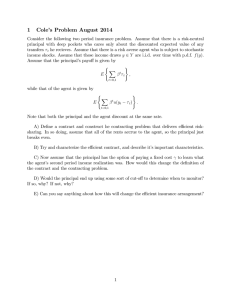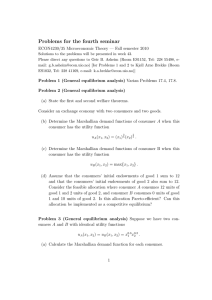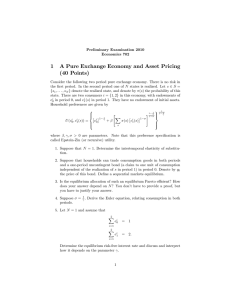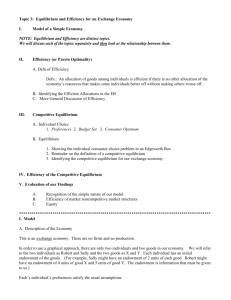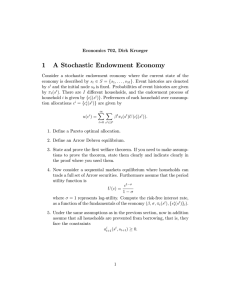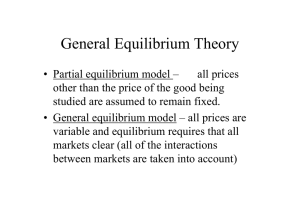Document 13422028
advertisement
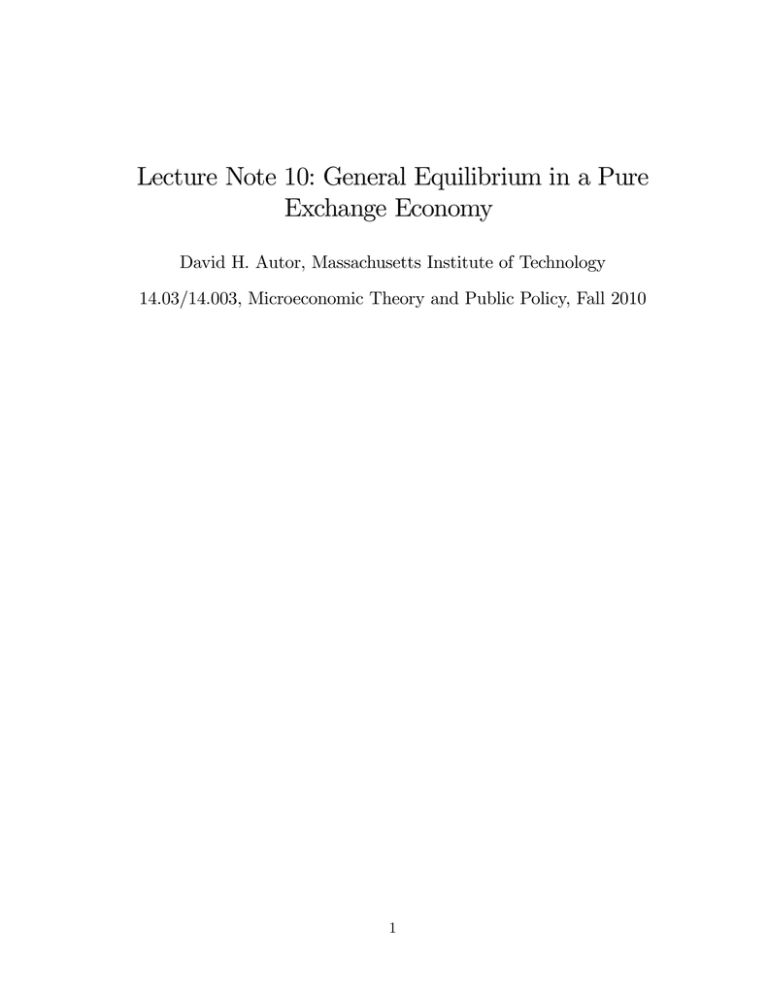
Lecture Note 10: General Equilibrium in a Pure Exchange Economy David H. Autor, Massachusetts Institute of Technology 14.03/14.003, Microeconomic Theory and Public Policy, Fall 2010 1 1 Motivation To now, we’ve talked about one market at a time: labor, sugar, food, etc. But this tool is a convenient fiction. Not always a badly misleading fiction. But still a fiction. Markets are always interrelated: • Reduce sugar tariffs → reduce sugar prices • → Drop in employment of sugar cane farmers • → Cane workers apply for other farm jobs, depress wages for farm workers generally • → Arable land is freed for other uses • → Gives rise to new crop production • → Prices of other farm products fall • → Real consumer incomes rise • → Rising consumer income increases demand for sweets, a luxury good • → The dessert market grows and the café sector booms • → Starbucks buys up all urban real estate in four major cities • ...there is literally no end to this chain of events. Viewed from this perspective, the notion of the market for a single good is a convenient fiction; all changes in quantities or prices ultimately feed back into the demand and/or supply for all other goods through several channels: • Income effects • Substitutability/complementarity of goods whose prices rise/fall • Changes in the abundance/scarcity of resources To understand this richer story, we need a model that can accommodate the interactions of all markets simultaneously and determine the properties of the grand equilibrium. What we need to develop is a general equilibrium model, in contrast to the partial equilibrium models we’ve used thus far this term. 2 2 The Edgeworth Box We need to reduce the dimensionality of the ‘all markets’ problem to something analytically tractable. But we need to retain the essence of the problem. The Edgeworth Box (after Jevons Edgeworth) allows us to do this. It turns out that we only need two markets to see the entire problem: • 2 goods • 2 people • Pure exchange. • Perfect expression of the economic concept of opportunity costs. • Simple as this model is, it can be used to demonstrate two of the most fundamental results in economics: the 1st and 2nd welfare theorems. [Note: We will not model or analyze the production of goods in this model, only pure exchange. The extension of the GE model to production is fascinating in its own right and well worth mastering, but I have decided that it needs to yield space to other topics in 14.03/14.003. If you would like to know something about GE with production, please ask for my GE lecture notes from 14.03/14.003 Spring 2003.) 2.1 Edgeworth box, pure exchange —Setup Two goods: call them food F and shelter S. Two people: call them A and B. The initial endowment: EA = (EAF , E AS ) EB = (EBF , E BS ) Their consumption: XA = (XAF , X AS ) XB = (XBF , X BS ) 3 Without trade: XA = EA XB = EB With trade, many things can happen, but the following must be true: X AF + X BF = E AF + E BF X AS + X BS = E AS + E BS Note the elements of this figure: • All resources in the economy are represented. • The preferences of both parties are represented. • The notion of opportunity costs is clearly visible. 14#1 ESB B Food E EFA UA0 EFB UB0 A ESA Shelter Starting from point E, the initial endowment, where will both parties end up if they are allowed to trade? It is not fully clear because either or both could be made better off without making either worse off. But it’s clear that they need to be somewhere in the lens shaped region between UA0 and UB0 . 4 How do we know this? Because all of these points Pareto dominate E : One or both parties could be made better off without making the other worse off. There are potential gains from trade. A would prefer more food and less shelter, B would prefer less food and more shelter. So hypothetically A gives up E AS − X AS A gains X AF − E AF B gives up X AF − E AF B gains E AS − X AS Are all points in the lens shaped region Pareto effi cient? No. All of the points in the lens region are Pareto superior, but only a subset are Pareto effi cient. Q: What needs to be true at a Pareto effi cient allocation? A: The indifference curves of A, B are tangent. Why? Otherwise, we could draw another lens. So trading should continue until a Pareto effi cient allocation is reached. Pareto effi cient allocation: 1. No way to make all people better off. 2. Cannot make 1 person better off without making at least 1 other person worse off. 3. All gains from trade exhausted. At a Pareto effi cient allocation, the indifference curves of A, B will be tangent. [Except in the case of a corner solution. Imagine if A didn’t like shelter and B didn’t like food. There is only one Pareto effi cient allocation in this case, and it is at a corner.] The set of points that satisfy this criterion is called the Contract Curve (CC). All Pareto effi cient allocations lie along this curve. We know that after trade has occurred, parties’set of choices will lie somewhere on CC that passes through the lens defined by the points interior to UA0 and UB0 . [In some examples, the Edgeworth box will not have a contract curve. That’s because, for problems that yield a corner solution, there will likely be no points of tangency between the 5 indifference curves of the two trading parties. But there may still be a set of Pareto effi cient points (on the edges) that dominate the initial allocation. For example, if A values good X but not good Y and vice versa for B, there will be no tangency points and the only Pareto effi cient allocation will involve giving the entire endowment of X to A and the entire endowment of Y to B.] 3 How do we get from E to a point on the contract curve? Famous analogy: Auctioneer (Leon Walras → Walrasian auctioneer). 1. In the initial endowment, the market clears (that is, all goods consumed) but the allocation is not Pareto effi cient. 2. So, an auctioneer could announce some prices and then both parties could trade what they have for what they preferred at these prices. 3. Problem: Choices would then be Pareto effi cient but would not necessarily clear the market. 4. It’s possible there would be extra F and not enough S or vice versa. 5. So, must re-auction at new prices... See Figure 2. 6 14#2 Food UB UA E Proposed price A Shelter • At proposed prices: • A wants to reduce consumption of shelter increase consumption of food • B wants to increase consumption of shelter decrease consumption of food • But, A wants to increase consumption of food more than B wants to decrease • A wants to decrease consumption of shelter more than B wants to increase • So: XAF + XBF > EAF + EBF ⇒ Excess demand XAS + XBS < EAS + EBS ⇒ Excess supply How do we know that it is ineffi cient for some of the shelter to go unused? What should auctioneer do? Raise PF /PS . When the auctioneer gets the price ratio correct, the market clears. No excess demand or supply for any good. This is a market equilibrium, competitive equilibrium, Walrasian equilibrium, etc: • Each consumer choosing his most preferred bundle given prices and his initial endowment. 7 • All choices are compatible so that demand equals supply. • Pareto effi cient consumption (‘Allocative Effi ciency’): � � � � ∂U/∂F ∂U/∂F = ∂U/∂S A ∂U/∂S B Q: How do we know Allocative Effi ciency will be satisfied? • Because both A, B face the same prices PF /PS . • Each person’s optimal choice will therefore be the highest indifference curve that is tangent to her budget set given by the line with the slope PF /PS that intersects E. • Because these choice sets (for A, B) are separated by the price ratio, we know they will be tangent to one another but will not intersect. (If we consider an economy with many goods, we can think of the equilibrium goods prices as forming a ‘separating hyperplane’– which is a generalization of a plane to more than two dimensions– that divides the indif ference maps of consumers to create the desired tangency condition across all goods). This equilibrium price ratio will exist provided that: • Each consumer has convex preferences (diminishing marginal rate of substitution) as we assumed during consumer theory. • Or, each consumer is small relative to the aggregate size of the market so that aggregate demand is continuous even if individual preferences are not. (This is obviously not relevant in the two person case represented by the Edgeworth box.) 4 Aside: How do we know that both (all) markets clear simultaneously? How do we know that both (all) markets clear simultaneously? Consider two goods X, Y and two individuals A, B. Label A� s demand and supply (endowment) of each good as DxA , DyA , ExA , EyA and similarly for consumer B. 8 Consumer A� s budget constraint can be written as: Px DxA + Py DyA = Px ExA + Py EyA , Px (DxA − ExA ) + Py (DyA − EyA ) = 0, Px ZxA + Py ZyA = 0, where ZxA is A� s ‘excess demand’for good X. ZxA = DxA − ExA . The excess demand is the amount of good A would like to consume relative to her current endowment (her ‘supply’). Excess demands can be positive or negative (so more precisely, excess demand or excess supply). The above equation states that given an initial supply (endowment) of goods and a set of prices, an individual’s total excess demand for goods is zero. Simply put, a consumer cannot buy more than the value of the goods she holds, since the value of these goods is her budget constraint. A similar budget holds for consumer B: Px ZxB + Py ZyB = 0. Putting these excess demand functions together, Px (ZxA + ZxB ) + Py (ZyA + ZyB ) = Px Zx + Py Zx = 0. and Px Zx = 0 ⇒ Py Zx = 0 Which is to say, that there cannot be either excess demand or excess supply for all goods simul taneously. This observation —that total excess demand must equal zero —is called Walras’Law (after Leon Walras who first provided this proof). Hence, if there are n goods, and there is no excess demand for n − 1 of these goods, then there is also no excess demand for the nth good. [We get the nth solution for free because we have one more linear equations than we have unknowns. That’s because we have one more goods than we have price ratios; good X, good Y , and price ratio px /py (as is obvious from the prior figure, it is only the price ratio not the absolute price level that matters). This fact implies that if we have n goods, the matrix of demands has rank n − 1. So, if we solve for market clearing prices of n − 1 goods, we have also obtained the market clearing price of the nth good.] In our two-good exchange economy above, this proves that if the market for food clears with no excess demand or excess supply, then the market for shelter clears simultaneously. 9 5 How are equilibrium prices set? First Welfare Theo rem You do not need the auctioneer. Leon Walras proved that the market can reach this equi librium without assistance from a central planner (auctioneer). “The self-organizing economy.” Process of Tattonment —translation ‘groping.’ This is a fundamental result. [I will not prove this. Consult a textbook as desired.] In partial equilibrium analysis, we have taken prices as exogenous. At the individual level, this is true. For all practical purposes, my preferences do not infiuence the price of sushi. But in aggregate, prices depend on preferences. The market trade-off among goods —that is, the price ratio — depends on the aggregation of the psychic trade-offs among all potential consumers. This equilibrium is a result of: 1. Endowments of all consumers 2. Preferences/tastes of all consumers (stemming from utility functions) 3. In a model with production: technologies for turning factors (land, labor, capital) into goods Notice that we have previously said in the partial equilibrium (PE) model of consumer choice that consumer’s optimal consumption bundle is a function of three things: 1. The consumer’s preferences 2. The market price ratio 3. The consumer’s budget In the GE model, these three items each have a direct mapping: 1. Preferences are a primitive in both models 2. The price ratio in the partial equilibrium (PE) model is an emergent property of the GE model stemming from preferences, endowments and technologies. While in the PE model, prices are exogenous, in the GE model, they are endogenous. 10 3. The budget in the PE model corresponds to the endowment in the GE model. In both models, the budget set can be thought of the endowment of goods that the consumer owns times their prices. However, there is an important difference between the two models. In the PE model, these prices — and hence the consumer’s budget set — is taken as given. In the GE model, the prices emerge from preferences, endowments and technologies. So, although the consumer has an exogenous endowment in the GE model, the corresponding budget set (i.e., the bundles that endowment can be traded for) is determined by the equilibrium of the model. 5.1 Effi ciency What Walras showed, and what is clear from the Edgeworth box, is that a competitive market will exhaust all of the gains from trade If the following conditions are satisfied... 1. No externalities 2. Perfect competition 3. No transaction costs 4. Full information then, the First Welfare Theorem guarantees that the market equilibrium will be Pareto effi cient. First Welfare Theorem: A free market, in equilibrium, is Pareto effi cient. 5.2 Another way to see this: We can think of the General Equilibrium problem as a utility maximization subject to three constraints: 1. No actor is worse off in the market equilibrium than in the initial allocation. How do we know this is satisfied? A person could always refuse to trade and consume her original endowment instead. Hence, no party can be made worse off by trade relative to her initial endowment. 2. In equilibrium, no party can be made better off without making another party worse off (otherwise there are non-exhausted gains from trade). 11 3. No more goods can be demanded/consumed than the economy is endowed with (a resource constraint). 3a [No goods are left unconsumed — that is, there is no excess supply. This is not truly a constraint —it’s simply a property of any equilibrium, which follows from non-satiation.] What the First Welfare Theorem says is that the Free Market Equilibrium is the solution to this problem. Simply by allowing unfettered trade among atomistic market actors, the market solution (i.e., the price vector and resulting equilibrium choices) will satisfy the three constraints above. This is an important and non-obvious result. It implies that the decentralized market continually ‘solves’ a complex, multi-person, multi-good maximization problem that would probably be extremely diffi cult for any one individual (or large government agency) to solve by itself due to the information requirements. Of course, markets are not always (or necessarily ever) ‘in equilibrium,’and conditions (1) - (4) for effi ciency are not always (or necessarily ever) satisfied. So, the market solution may not be perfect. But one should also ask: would a ‘central planner’generally do better? 6 Second Welfare Theorem Q: Does the 1st Welfare Theorem guarantee that the market allocation will be ‘fair’or equitable? No. Giving everything to A in the initial endowment would be Pareto effi cient, as would giving everything to B. The 1st Welfare Theorem simply says that the market will enlarge the pie as much as possible; it has nothing to say about who gets what share. So, is there a trade-off between enlarging and dividing the pie (that is, between effi ciency and equality)? Stated rigorously, given a Pareto effi cient allocation of resources, will there exist prices and an initial endowment such that this allocation is an equilibrium? If the answer is yes, there is no trade-off. If no, there is. The 2nd Welfare Theorem proves that the answer is yes. Second Welfare Theorem: Providing that preferences are convex, any Pareto effi cient allo cation can be a market equilibrium. The reasons are self-evident in the Edgeworth diagram (though this is a far from a proof). 12 • Along the contract curve, every point represents the tangency point of two indifference curves • This tangency point corresponds to a price ratio that separates the two tangent indiffer ence curves • This price ratio clearly must exist if the indifference curves are tangent and each is convex (so they don’t recross at some later point) • This price ratio is therefore the market price vector that will support that particular Pareto effi cient allocation. Hence, it is immediate from the Edgeworth box that all Pareto effi cient distributions —that is, all points on the CC —are feasible as market equilibria. As long as the assumptions above are met, a competitive equilibrium will exist merely because each person is self-interestedly maximizing her own well-being. The Second Welfare Theorem says that any Pareto effi cient allocation can be maintained as a competitive equilibrium. This means that the problems of equity/distribution and effi ciency can be separated. The Second Welfare Theorem therefore implies that there is no intrinsic trade-off between equity and effi ciency. [Notice that the converse is also generally true: non-Pareto effi cient allocations cannot be attained in equilibrium.] When we discuss partial equilibrium welfare analysis (as in the sugar case), we implicitly assumed that it was justifiable to maximize the sum of producer and consumer surplus, rather than worrying about their division. The 2nd welfare theorem is what justifies that approach. 6.1 If we don’t like the distribution of wealth in the market equi librium, how do we change it? How do we get from one Pareto effi cient allocation to another? It would seem that there are two tools available: lump-sum redistribution (i.e., where I reallocate food and shelter from A to B) and taxation to change the price ratio so that a different equilibrium obtains. But these tools are not equivalent. What happens when you change the price ratio (by fiat) in this model to achieve some alternative equilibrium? The answer is clear from studying the Edgeworth box. Also, think back to our earlier discussion of lump-sum taxation versus taxing 13 a single good to alter the price ratio. Finally, notice that taxing all goods simultaneously here would not alter the price ratio but would also not achieve redistribution. 7 Interpreting the Fundamental Welfare Theorems The fundamental welfare theorems provide some very basic policy guidance: • The function of the price mechanism is to ensure that all resources are consumed in a Pareto effi cient fashion —all gains from trade are exhausted. • This occurs automatically as prices adjust to clear the market. • Distorting the price system to achieve equity is generally not a good idea (as you will explore in Pset #4). Distorting the price system generally does create a trade-off between effi ciency and equity– which is exactly what the Welfare theorems say we do not need to do. • This does not mean we should ignore equity, however. We can achieve whatever ‘equitable’ allocations of resources is desirable through lump-sum distributions. Is this dictum —don’t distort prices —always correct? No. Because the strong assumptions underlying the Welfare Theorems are not always —or perhaps ever —satisfied. But it does build a prima facie case that free market outcomes may be effi cient —or at least hard to improve upon. Improving on them requires a careful analysis of why they are not desirable; and preferably a proposed solution that harnesses the useful properties of markets rather than attempting to override these properties. When there is a case to be made for manipulating market outcomes (and there often is), this case probably should depend upon: • A reasoned diagnosis as to why the market allocation is not optimal. • A policy prescription that builds on an analysis of how a specific intervention will remedy this fault. • A careful accounting of the likely distortions (deadweight losses) that will result from tampering with the price system. 14 7.1 Are the welfare theorems non-obvious? Paul Samuelson once said, “There are few things in economics that are both true and nonobvious.”The fundamental welfare theorems are arguably one of those exceptional things. Why would anyone assume that prices are other than arbitrary social creations? This insight– that the free market system generates a Pareto effi cient equilibrium through the en dogenous emergence of prices– is non-obvious. And in fact in most of human history, prices and market operations have been viewed with a great deal of suspicion. Economic theory suggests that market equilibria (and prices themselves): • Have a fundamental logic • This logic is an emergent property of the rational, atomistic actions of market participants. The key insight: Blind pursuit of self-interest by autonomous actors in a market setting yields collectively welfare maximizing behavior. Under certain (strong) assumptions, this equi librium cannot be improved upon without making at least one person worse off (Pareto effi ciency). Adam Smith published The Wealth of Nations in 1776. It’s clear that Smith intuitively understood the First Welfare Theorem in The Wealth of Nations. For example, he wrote: “It is not from the benevolence of the butcher, the brewer, or the baker, that we expect our dinner, but from their regard to their own interest. We address ourselves, not to their humanity but to their self-love, and never talk to them of our necessities but of their advantages.” And: “Every individual necessarily labors to render the annual revenue of the society as great as he can. He generally indeed neither intends to promote the public interest, nor knows how much he is promoting it. ... He intends only his own gain, and he is in this, as in many other cases, led by an invisible hand to promote an end which was no part of his intention. ... By pursuing his own interest he frequently promotes that of the society more effectually than when he really intends to promote it. I have never known much good done by those who affected to trade for the public good.” 15 Clearly, Smith had convinced himself of the first welfare theorem (not obvious that he thought of the 2nd). But it was 150 years until either welfare theorem was proved. • Pareto and Barone proposed the 1st and 2nd welfare theorems formally in the 1930s. • These theorems were proved graphically in 1934 by Abba Lerner. • They were proved mathematically by Oskar Lange in 1942 and Maurice Allais in 1943 (for which Allais won the Nobel Prize in Economics in 1988). Prior to Adam Smith– and long afterward– market behavior has been viewed with great suspicion. An example from Helibroner (1953), The Worldly Philosophers (New York: Touch stone). In 1639 in Boston, the respected merchant Robert Keayne was charged with a crime: He had made over sixpence profit on the shilling, an outrageous gain. The Boston court debated whether to excommunicate him for his sin. In view of his spotless past, the court instead fined him 200 pounds (a huge sum!). Keayne was so distraught over his sin that he prostrated himself before the church elders and “with tears acknowledges his covetous and corrupt heart.” The minister of Boston could not resist the opportunity to make an example of Keayne. In his Sunday sermon, he used the example of Keayne’s avarice to denounce “some false principles of trade:” 1. That a man might sell as dear as he can, and buy as cheap as he can. [Buying low, selling high.] 2. If a man loses by casualty of sea, etc., in some of his commodities, he may raise the price of the rest. [A reduction in supply may increase the market price.] 3. That he may sell as he bought, though he paid too dear. [Selling at a price that the market will bear.] That free markets may produce socially desirable outcomes is a fundamental insight of economics. Two-hundred and thirty years after Smith wrote The Wealth of Nations, this idea is not widely understood outside of the economics profession, though it has had a profound effect on the organization of modern economies. 16 8 Applying the GE Framework to Consumer Markets: Fishing in Kerala (Jensen, 2007) We will discuss the details of the “Digital Provide”paper in class. There are three substantive points related to the paper that I’d like to explore in some detail in the lecture notes. These are: 1. How we see the gains from trade in Kerala in the Edgeworth box 2. How we know that the integration of markets must be welfare enhancing 3. What is ‘the law of one price’and why is it relevant here? 8.0.1 Gains from trade in Kerala in the Edgeworth box Consider the Edgeworth box below with two consumers, A and B, who have two sources of nourishment: rice and fish. Each day, A and B harvest a fixed quantity of rice (depicted by the dashed line) and they also go fishing. On some days, the fish schools are primarily in A’s fishing area and on some days, the fish schools are primarily in B’s fishing area. Let’s assume for simplicity that their total catch (the sum of their two catches) is identical on each day. That is, their catches are inversely correlated so that when A has a big catch, B has a small catch and vice versa. In this diagram, the curve connecting the vertices is the Contract Curve, i.e., the set of Pareto effi cient allocations. In autarky (that is: no trade), A and B each consume their own endowments each day. This is clearly not Pareto effi cient. The lens shape regions extending from the two different endowments (big catches for A and B, respectively) show the unexploited gains from trade. If A and B could trade fish for rice, this would improve the welfare for both parties under both sets of circumstances (i.e., A or B has a big day). Even though A is relatively wealthy in one state and B is relatively wealthy in the other, both benefit from the opportunity to trade on all occasions. 8.0.2 Further gains from market integration If fish were storable, A could simply pool (no pun intended) her catch across good and bad days. This would give her the option to consume the same amount of fish each day. Of course, B could do similarly. Since fish is not storable, this cannot occur. However, A and B could agree to share their fish so that on any given day, they pool and split their catch. 17 18 The possibility of pooling the catch is illustrated in the diagram above as the midpoint between the two endowments corresponding to good days for A and B. Notice that even at this mid-point, A and B would want to trade further to reach the contract curve; given identical endowments, A would prefer more rice and B would prefer more fish. Thus, their preferences are not identical. Would A and B prefer to ‘pool’ their fish catch each day and then trade? Or would they prefer to trade from their autarkic endowment each day? Or is the answer indeterminate? Unfortunately, this question is diffi cult to answer with the tools currently at our disposal. (We’ll come back to the question later in the semester, however, when we study risk and insurance.) Let’s instead consider a slightly simpler question. Imagine that A and B each have the same amount of wealth each day but that the amount of fish they can consume is constrained by their catch. In this setting, we can ask if they prefer to pool their catch each day or if they would be equally happy to eat more fish one day and less the other. We’ll use a simple parametric example to answer the question, but the answer is in fact a general one. Assume that both A and B have standard preferences, and their Marshallian demand curves for fish are unambiguously downward sloping. for fish. Assume that fish is a small part of their consumption bundles, so that income effects can be ignored (so Hicksian and Marshallian demand are close to identical). Holding wealth and the price of all other goods constant, assume that both A and B have personal demand curves of the form:1 Q = 60 − P. That is, if the price of fish is 20, A and B would buy 60 − 20 = 40 fish. On a good day, A catches 40 fish, and on a bad day, she catches 20. B � s catches are just the opposite: when A has a good day, B catches only 20 fish, and when A has a bad day, B catches 40 fish. Would A and B prefer to consume 40 and 20 fish each on alternating dates, or would they prefer to consume 30 every day? To answer this question, we need to calculate the utility A gets from these bundles. Although we cannot answer this question in terms of ‘utils,’we can answer it in terms of willingness to pay (WTP), which is simply the area under the demand curve. Inverting the demand curve above gives us A� s (and B � s) the price that A and B would pay 1 Our substantive conclusions do not depend on their demand curves being identical. They just need to be downward sloping. 19 for fish as a function of quantity: P = 60 − Q. They are willing to pay $59 for the first fish, $58 for the second, etc. So, how much are they willing to pay for Q fish? The answer is the area under the demand curve: � Q W T P (Q) = P (Q) dQ 0 � Q = (60 − Q) dQ 0 �Q � Q2 = 60Q − + c�� 2 0 Hence, on high and low days, their total WTP for the fish they consume is: �40 � Q2 W T P (40) = 60Q − + c �� = 2400 − 800 + c − c = 1, 600 2 0 W T P (20) = 1200 − 200 = 1, 000. Hence, total WTP across the two days is 2, 600 and average W T P is 1, 300. Now, if A and B split their catch each day, they’d each get 30 fish. How much would they be willing to pay to consume this quantity daily? W T P (30) = 1800 − 450 = 1, 350. In this case, total WTP across two days is 2, 700 and average W T P is 1, 350. Clearly, A and B would prefer to split their catch every day rather than eat more fish on high days and less fish on low days (that is, 2 × W T P (30) > W T P (40) + W T P (20)). We said above that this result is general. How do we know? Consider the diagram below. The three regions of this figure correspond to the consumer’s willingness to pay for the first 20, next 10, and subsequent 10 fish. Call these areas a, b and c. If the consumer eats 40 fish one day and 20 the next, her total willingness to pay is: W T P (40) + W T P (20) = a + (a + b + c) = 2a + b + c If the consumer instead eats 30 fish on both days, her total W T P is: 2 × W T P (30) = 2a + 2b Since area b is greater than area c, it’s immediately evident that the consumer prefers to smooth consumption– that is, consume a consistent quantity rather than experiencing feast and famine. 20 21 This result follows directly from consumers’ diminishing marginal rate of substitution. If the marginal utility of fish is declining in consumption, the consumer obtains less utility from consuming two extreme bundles (one high in fish, one low in fish) that from consuming the average of these two bundles twice. Notice that this result would not hold absent diminishing MRS for fish. In that case, the demand curve for fish would be perfectly elastic (meaning a straight horizontal line at a fixed height), and the consumer would be indifferent between the average bundle and the two extreme bundles. Returning to the gains from trade, this example suggests that A and B can improve welfare not merely by trading from their autarkic position each day but also from trading over time by pooling resources. Thus, we could reconstruct our Edgeworth box as having a third dimension equal to time. Although A and B cannot store fish, they could share their hauls, which would have the effect of reducing the swings in consumption over time for each party. 8.0.3 Applying ‘the law of one price’ The law of one price states that in competitive equilibrium, prices for a given commodity should be equalized across markets. This is a necessary condition for Pareto effi ciency because, if prices differ for the same commodity, consumers will not in equilibrium equate their MRS between this commodity and all other goods with one another (i.e., with other consumers). In that case, there would be unexploited gains from trade, leading to an arbitrage opportunity. Definition 1 Arbitrage. (1) Taking advantage of a price difference between two or more mar kets. (2) Striking a combination of matching deals that capitalize upon the imbalance between prices. The ‘law of one price’implies that arbitrage opportunities should not exist in equilibrium. You may ask: who enforces this law? Let’s say that you observe that rice sells at one price in Northern China and another price in Southern China. Is there any limit on how much we might expect these prices to differ? Yes. If rice can be transported between North and South– and if buyers and sellers are aware of this price difference– then the price difference between markets should not be greater than the transport cost. If the price difference were greater than the transport cost, a trader would find it profitable to transport rice between North and South to arbitrage the price difference. This would have the effect of lowering the price in the more expensive market (by increasing supply) and raising it in the less expensive market (by reducing supply). Such trade should be 22 expected to continue until the prices differ by no more than the transport cost. At this point, there are no further arbitrage opportunities. Thus, arbitrage enforces the law of one price. Jensen tests this idea in Table VII of the ‘Digital Provide’– specifically, does the law of one price hold across fish markets in Kerala. The answer appears to be that before the introduction of cell phones, it does not. After the introduction of cell phones, it appears to hold almost all of the time. Thus, for arbitrage to work, two things are needed: (1)There is a cost-effective means to transport fish between local markets in Kerala; (2) There is a mechanism (cell phones) that allows sellers to learn about the price differentials across markets. Thus accurate and inexpensive information is crucial to the effi cient operation of markets. Assume now that fishermen and consumers are not the same people. In particular, fisherman C and fisherman D face the demand curves above from A and B. On alternating days, C catches 20 fish and D catches 40 fish (and vice versa). C and D can choose to pool their catches and sell 30 fish each to A and B each day. Or, they can keep their catches separate and sell 20 and 40 fish to consumers A and B on alternating days. Which approach is profit maximizing for C and D? Which maximizes consumer surplus for A and B? Which approach maximizes social welfare? 23 MIT OpenCourseWare http://ocw.mit.edu 14.03 / 14.003 Microeconomic Theory and Public Policy Fall 2010 For information about citing these materials or our Terms of Use, visit: http://ocw.mit.edu/terms.
